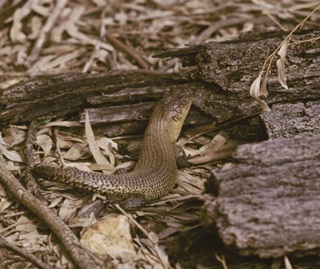 Camp fires provide light, warmth and heat for cooking. However, the increasing removal of standing dead timber and woody debris can contribute to the decline of native forests. Dead hollow-bearing trees and woody debris provide habitats for many native animals including Cunningham’s skink (Egernia cunninghami) and the endangered turquoise parrot (Neophema pulchella).
Camp fires provide light, warmth and heat for cooking. However, the increasing removal of standing dead timber and woody debris can contribute to the decline of native forests. Dead hollow-bearing trees and woody debris provide habitats for many native animals including Cunningham’s skink (Egernia cunninghami) and the endangered turquoise parrot (Neophema pulchella).
In some parks the removal of woody debris may be a fire management practice, helping to reduce fire risk.
Policy
- Collecting firewood from within a park to use outside of a park is prohibited.
- Collecting timber for firewood is allowed in backcountry (more remote) areas, in any park category, except where it is:
- prohibited by a park plan of management
- prohibited by a sign or notice
- for commercial gain
- for use outside the park boundary.
3–8. Exemptions
- Upon the reservation of new lands, where collection was being undertaken at the time of reservation and is not for commercial gain, a limited phasing-out period may apply (upon request).
- Firewood collection for domestic use may be permitted in some parks and reserves in the Riverina region of NSW. Further information is available on the domestic firewood collection page.
- In parks other than nature reserves, the NSW National Parks and Wildlife Service (NPWS) may allow firewood collection:
- where there are management activities or developments that
- have already been assessed for environmental impacts (including consideration of key threatening processes
- have required the removal of vegetation.
Such activities include infrastructure maintenance, construction, the removal of hazardous trees, weed control and rehabilitation.
- in areas within strategic fire advantage zones or asset protection zones identified under fire management strategies (this may include zones around cultural heritage assets)
- in designated low-use areas where NPWS has determined that firewood collection does not have a significant ecological impact
- in areas identified under a plan of management as suitable for ecologically sustainable firewood collection. Such areas may include plantations in parks that existed prior to the park’s establishment
- in areas other than those listed above. However, this is permitted only following:
- documented assessment of impacts on threatened species listed in the removal of dead wood and dead trees key threatening process
- approval by the relevant NPWS Director.
- where there are management activities or developments that
- In designated camping areas, NPWS may provide firewood for use in parks, and/or provide alternative fuel and cooking facilities.
- Where firewood is provided, NPWS may obtain it either:
- in accordance with paragraph 3 of this policy
- from off-park sources; where this is the case, the wood should if possible be from sustainably managed sources with low environmental impact (for instance, untreated offcuts).
Cost-recovery pricing is to be used where practicable. Under appropriate licensing arrangements, contractors may sell firewood to park visitors.
- Where fires are allowed and there is no provision on park of firewood or alternative fuel and cooking facilities, park visitors should be encouraged to bring non-pathogen/pest-bearing fuels (such as gas) for use on park.

